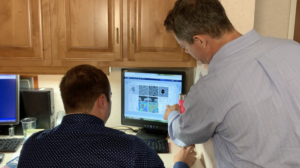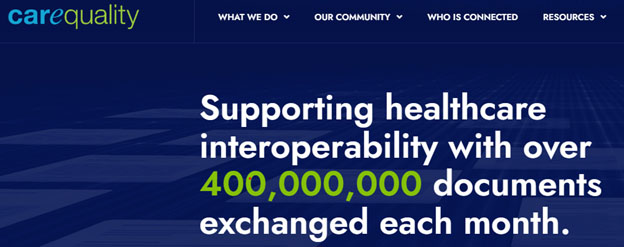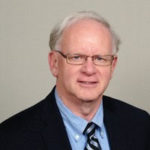
Michael Cymbor, OD, co-manages a patient with a colleague. Dr. Cymbor is on the Advisor Panel of Healthcare Registries as Co-Chair of our Diabetic Management Registry. The other Co-Chair is Chris Cooper, OD.
Teaming with other healthcare providers to ensure the best patient outcomes.
By James E. Grue, OD,
Ronald P. Snyder, OD, FAAO,
and Michael J. Lipson, OD, FAAO, FSLS
March 6, 2024
Few eyecare providers can articulate what it means to be part of a patient’s care team or understand what the expectations are for a member of a care team.
In the past, it did not matter. But the healthcare system in the U.S. is changing, and you are already part of every patient’s care team. It is important that you understand the role you play in the care team.
What is a “Care Team”?
Care teams are not something that someone creates and assigns patients to. Every patient has their own unique care team. How do you get on the team? Every certified EHR and every Consolidated Clinical Document Architecture (C-CDA) used to share patient health information between providers is required to list the patient’s care team. Any provider can build or add to the care team list. Most primary care providers prefer to know of all the other providers a patient sees.
Other Articles to Explore
At routine primary care visits, it is becoming more common for a nurse or other staff person to ask the patient to tell them every provider they see. If the patient tells them you are their eyecare provider, you are automatically added to the care team list. After that, any other healthcare provider the primary care physician electronically communicates with will see that you are part of the patient’s care team as their eyecare provider. That is all it takes.
Why is it Important to Be Acknowledged as Part of the Care Team?
The single biggest objective of healthcare reform is to eliminate one fundamental flaw in the traditional healthcare delivery system: patient health information that is not consolidated in one place and stored in limited segments in each provider’s EHR. This provider information includes the office of the patient’s primary care physician, cardiologist and even a hospital which may contain additional information. Traditionally, there has been no one way or one place to accumulate and consolidate all of this information.
Regulators recognized that this flaw had to be corrected if we were going to deliver better healthcare in the U.S. They also recognized that three solutions would require legislative action. A healthcare provider can voluntarily participate in any of these solutions, but may be required to participate in others. All three legislative actions make possible the concept of a longitudinal patient health record where all the patient’s health information resides either in a central location or by an easily accessible process.
3 Solutions to Consolidating Patient Information
- Health Information Exchanges (HIEs)
- All 50 states have at least one HIE.
- You can participate in your state HIE now. To participate, your EHR needs to have an integration with the HIE or support Kno2 or Carequality.
- Some states already have legislation which requires all licensed providers in the state to participate in their state HIE. If you practice in one of those states, it is likely that you have been informed of this by your state optometric association or by your state licensure board.
- FHIR (Fast Healthcare Interoperability Resources) servers
- Whether you are aware of it or not, at the end of every exam you perform, your certified EHR is required to automatically transfer an exam summary to a FHIR server. Eventually your patients, and anyone you or your patient authorizes, can access the information.
- At this time, the FHIR server is not yet fully functional. Once it becomes functional, it will be a powerful solution for accessing all patient health information.
- Carequality
- This technology is, most certainly, already being used to find patient health information by other health facilities in your community.
- The technology that the national patient health exchange network is built on is called TEFCA (Trusted Exchange Framework and Common Agreement).
- To launch the Carequality website, click HERE.
Carequality – Interoperability Framework
On the top of the homepage, click the tab “Who is Connected.” Next, enter your local zip code. This will enable you to see all of the healthcare organizations in your area that are already participating and sharing patient health information via Carequality.
- Every major hospital-based EHR system and many eyecare EHRs already support Carequality.
- At the current time, it is your choice whether to participate or not.
Let us go back to the question of why you might want to be listed on the patient care team. The Carequality technology works by going out and retrieving the same exam summary report that your EHR sent to the FHIR server. When a request comes in from Carequality, your exam summary, which has been saved internally by your EHR, is found and sent to the requesting organization.
Carequality is implemented by searching and requesting documents from those providers who are members of the patient care team. If you are not on the patient’s care team, or are not participating in Carequality, the system is not going to find any information on the patient even though you have provided care to the patient.

To learn more: 844.393.3282. (toll free) or ContactUs@HealthCareRegistries.com
Understanding all of this, you get to choose whether you want to be part of this emerging care delivery system or not. It really comes down to how important it is to your patients to have all of their health information in one place and accessible to the entire care team.
We know that, nationally, over 90 percent of patients want their information to be shared. We know this fact because patients must agree to have their information shared through an HIE, and the data shows that less than 10 percent of patients opt out. As a general rule, healthy patients do not care, but almost all patients under treatment want to have their information available to other providers involved in their care.
If your practice consists of primarily young healthy patients, this probably is not an issue of much concern. But if you see a lot of older patients, or patients with multiple health issues, you should at least consider participating in Carequality. Most patients don’t want to jump through hoops for their providers to access their health information. Desiring ease of access to information, they may choose to switch to providers that do participate in Carequality.
One last word of advice. Even though you may not be aware of Carequality in your community, or haven’t heard about it from your patients, don’t assume these things are not happening.
A few months ago, a provider in a small rural town insisted that a hospital in his town would not be able to receive his diabetic reports electronically through Direct Secure Messaging (DSM) from his EHR. One of the authors of this paper called the hospital and was told, “We have been using DSM for over three years and prefer that all communications with their providers be through DSM instead of fax.”
Below is a screenshot from the Carequality website. With 400 million documents being shared each month, it is likely that patient information is being shared in your community in this way without you even being aware of it.

For those providers who decide to actively participate in electronically exchanging patient health information, our next article will address data integrity and why it is important that the information sent to other providers is accurate and comprehensive.
 James E. Grue, OD, is a health-care reform speaker and consultant. To contact him: JimGrue@HealthCareRegistries.com
James E. Grue, OD, is a health-care reform speaker and consultant. To contact him: JimGrue@HealthCareRegistries.com
 Ronald P. Snyder, OD, FAAO, is the president and CEO of HealthCare Registries, LLC. To contact him: RonSnyder@HealthCareRegistries.com
Ronald P. Snyder, OD, FAAO, is the president and CEO of HealthCare Registries, LLC. To contact him: RonSnyder@HealthCareRegistries.com
 Michael J. Lipson, OD, FAAO, is the chairman of the OrthoK Advisory Panel of HealthCare Registries, LLC.
Michael J. Lipson, OD, FAAO, is the chairman of the OrthoK Advisory Panel of HealthCare Registries, LLC.

























